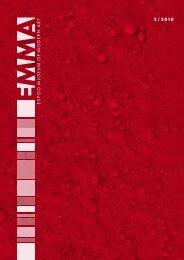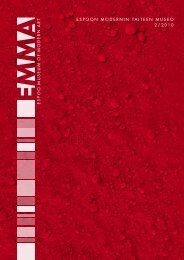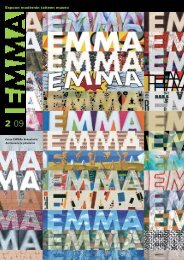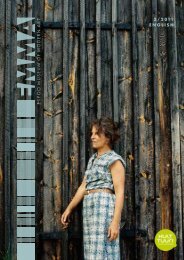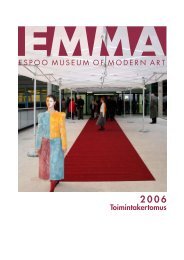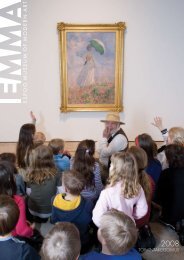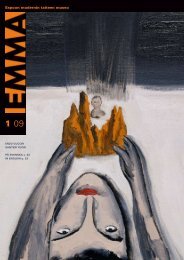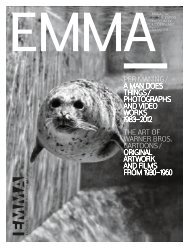EMMA Magazine 2/2012
EMMA Magazine 2/2012
EMMA Magazine 2/2012
Create successful ePaper yourself
Turn your PDF publications into a flip-book with our unique Google optimized e-Paper software.
magazine<br />
of the Espoo<br />
Museum of<br />
modern art<br />
Summer <strong>2012</strong>
2<br />
3<br />
Ted Hesselbom, director of<br />
Röhsska Museet, the Swedish design<br />
museum, offers a Swedish view<br />
of Nordic design developments.<br />
Photos / Mikael Lammgård<br />
Which way is Nordic design<br />
identity heading? After half<br />
a century of international success,<br />
designers are now questioning<br />
and confronting traditions.<br />
Integration &<br />
Disintegration<br />
Nordic Design Today<br />
The exhibition features five leading<br />
designers and design groups<br />
active in fields including fashion,<br />
furniture, lighting and glass art.<br />
The exhibited artists are Steinunn<br />
Sigurðardóttir from Iceland,<br />
Harri Koskinen from Finland,<br />
Henrik Vibskov from Denmark,<br />
and the design groups Norway<br />
Says from Norway and Front from Sweden.<br />
They are the latest recipients of the prestigious<br />
annual Torsten and Wanja Söderberg Prize<br />
for design, which is funded by the Torsten and<br />
Ragnar Söderberg Foundations. The prize,<br />
awarded by the Röhsska Museum in Gothenburg,<br />
is the world’s biggest design distinction of<br />
its kind. The prize sum of one million Swedish<br />
kronas is awarded each year to a designer or artisan<br />
from the Nordic countries.<br />
These five designers and design groups are<br />
good ambassadors for contemporary Nordic design,<br />
which is currently reimagining itself with<br />
a new identity, partly in direct opposition to the,<br />
until recently, prevailing trends of functionalism<br />
and simplicity. They demonstrate many different<br />
links to the spirit of the turn of the last century.<br />
Their works include more historical references<br />
than those of most Nordic designers of the late<br />
twentieth century.<br />
Norway Says<br />
This is a Norwegian design group that could be<br />
credited with putting Norway on the international<br />
design map towards the end of the twentieth<br />
century and the beginning of the twenty-first.<br />
The group is a real embodiment of the renaissance<br />
experienced by Scandinavian design in the<br />
NORWAY SAYS. <strong>Magazine</strong> stand, 2008.<br />
1990s – renaissance in the sense of a renewed<br />
dominant focus on aesthetics and sparseness.<br />
This stands in contrast to the spirit of the 1960s<br />
and 70s, where steps were taken away from the<br />
unique and the elitist in the design industry in<br />
favour of creating items of “general good taste”<br />
that took design to the masses. The mid-to-late<br />
century was also a politically and socially aware<br />
period in form and design. The minimalism of<br />
the 1990s, on the other hand, fulfilled demands<br />
to recapture the Scandinavian aesthetic. The<br />
Norway Says magazine holder is a very good<br />
example of that time. Made out of light wood<br />
pressed into a stylised and simple form, it retains<br />
a high degree of functionalism. When<br />
the three members of Norway Says – Torbjørn<br />
Anderssen, Andreas Engesvik and Espen Voll –<br />
received the Torsten and Wanja Söderberg Prize<br />
from the Crown Princess of Sweden, in front of<br />
an enlarged image of a romantic Norwegian fjeld<br />
landscape in glittering sunshine, design seemed<br />
to be light years away from politics and the ideology<br />
of “beautiful everyday items”.<br />
The trends were blond wood, minimalism<br />
and sparseness, even more so than in the work<br />
of their precursors from earlier years. To some<br />
extent, it was a vintage period that refined modernism<br />
and functionalist architecture. In most<br />
Nordic metropolises, the trend resulted in new<br />
harbour-side districts built with a lot of glass<br />
and balconies in an updated functionalist style.<br />
The 1990s will probably be filed under ‘minimalism’<br />
as regards the Nordic countries.<br />
Norway Says is a national phenomenon (note<br />
the choice of name, with its clear patriotic link)<br />
with, I feel, one foot solidly in 1990s minimalism.<br />
Always pioneering, the group took steps in<br />
the early 2000s towards the local and popular<br />
inspiration found in folk tales and myths – into<br />
a new kind of national romanticism.
4<br />
5<br />
Norway Says draws inspiration from the Nordic<br />
region as a whole, and a perfect example of<br />
this is their pendant lamp in matte metal, which<br />
imitates the shape of the hairstyle of the Finnish<br />
fictional figure Little My. Nordic traditions can<br />
also be seen in their turned wood and choice of<br />
light-coloured wood species. Despite their apparent<br />
functionalism and modernism, they have<br />
been among the first to adopt a more romantic approach<br />
to history and functionalist design, going<br />
beyond aesthetics and nostalgia. They belong to a<br />
new generation, which has the courage to redefine<br />
and improve upon history using digital tools.<br />
Design Becomes Normative<br />
The twenty-first century began with some quickly<br />
aborted attempts to create a new futurist spirit<br />
with laboratory-style, sterile interiors, using only<br />
white, high-tech materials pictured in design<br />
and fashion magazines. These were reminiscent<br />
of the optimistic astro-futurism of the 1960s, as<br />
pioneered by designers such as André Courrège<br />
and the Dane Verner Panton. Around the year<br />
2000, the tone was set by Martin Margiela, with<br />
his painted-white clothes and store designs, and<br />
Marcel Vanders, with his company Moooi. At the<br />
Salone del Mobile furniture fair in Milan, almost<br />
all the floors were white, glossy and unsullied by<br />
human activity.<br />
These futurist visions were abruptly interrupted<br />
by the terrorist attacks of 11 September<br />
2001, in which militant Arab factions razed the<br />
New York World Trade Center in a stand against<br />
Western dominance. In Sweden, the Scandinavian<br />
minimalist era of the 1990s came to an end<br />
with the government-appointed Year of Design in<br />
2005. Before that, design had been exclusive and<br />
the editor-in-chief of Wallpaper magazine, Tyler<br />
Brûlé, had taken it upon himself to dictate the<br />
prevailing trends (among other things, appointing<br />
Stockholm as the trendy city of 1999). During<br />
the Year of Design, it was the prime minister<br />
and other representatives of the powers to be who<br />
took custody of the word ‘design’ and thereby<br />
stamped it as uninteresting and normative.<br />
The attention of students at Konstfack University<br />
College of Arts, Crafts and Design and<br />
the HDK School of Design and Crafts shifted towards<br />
handicrafts and sustainability, and some<br />
FRONT. Horse lamp designed for Moooi, 2005.<br />
started labelling themselves as craftsmen. There<br />
was talk of new leftist winds, but the only thing<br />
that happened was that the arts and crafts scene<br />
took over the role of the trendsetter. The path<br />
for this shift was laid by a heated debate around<br />
diversity as the loftiest of objectives.<br />
Year of Design in Sweden 2005<br />
vs. WDC Helsinki <strong>2012</strong><br />
A comparison between Sweden’s Year of Design<br />
in 2005 and Helsinki’s World Design Capital status<br />
in <strong>2012</strong> may be vain from a Swedish perspective.<br />
It seems evident to me, however, that the<br />
Year of Design came either too late or too early. I<br />
believe it was partly conjured forth as a political<br />
concession by authorities who hoped for more<br />
collective efforts in design.<br />
WDC Helsinki <strong>2012</strong>, as I see it, comes at a<br />
time when a new attitude towards design has already<br />
matured. Some see design as nationalistic<br />
and therefore exclusive and elitist, but even that<br />
perspective seems antiquated now. It is a fact<br />
that there are nationalist movements in Nordic<br />
politics right now, and their existence at a high<br />
governmental level has brought questions of cultural<br />
heritage to the forefront for many people,<br />
even though they are often linked with racism<br />
and intolerance. I maintain that artisans and designers<br />
have been frontrunners in applying cultural<br />
heritage in a novel way, without letting it<br />
be tainted by intolerance. If anything, their way<br />
of relating to traditions has freed culture from<br />
possession by powers on the far right. Suddenly<br />
there are many of us who want to protect folk<br />
dancing and regional costumes, while ensuring<br />
that they have nothing to do with racism or similar<br />
tendencies, which would have it that some<br />
cultures are purer or better than others.<br />
Steinunn Sigurðardóttir’s relationship with<br />
the very special Icelandic landscape and Harri<br />
Koskinen’s textiles are good examples of this. On<br />
the surface, they represent modernism and simplistic<br />
Nordic design, but their content is reflective<br />
and inspired by folk traditions.<br />
Twenty-First Century Romanticism<br />
Since 2005, the new century has been filled with<br />
ideas of reuse and sustainability. Large parts of<br />
the development of fashion, design and handicrafts<br />
have been characterised by historical references<br />
to similar movements in the late 1800s.<br />
Values have also shifted from objective good<br />
FRONT.<br />
Blow Away vase, 2008.<br />
Many things which<br />
were long under taboo<br />
come back into fashion<br />
and many others<br />
strongly resemble 19 th<br />
century eclecticism.<br />
Ted Hesselbom on<br />
Nordic design in the 2000s.<br />
taste to the subjective and the individual. Interest<br />
is drawn towards uniqueness and diversity<br />
rather than mass production and industrial collaboration.<br />
Working with industry was, back in<br />
the 1960s, initially a democratic move for many<br />
designers, a revolt against providing one-of-a-kind<br />
beautiful items for the lucky few. The revolt of the<br />
twenty-first century is, instead, against a design<br />
market and design production that are seen as exclusive<br />
and elitist. Today’s one-of-a-kind objects<br />
are inclusive; there is no single correct way of doing<br />
things. Movements such as do it yourself and<br />
fashion exchanges stand for recycling and sustainability<br />
and imply that all the different folk cultures<br />
of the world are equally valuable. Many of<br />
them are now represented in every Swedish city.<br />
Since 2000, Sweden has had five official minority<br />
languages: Finnish, meänkieli (Torne<br />
River dialects), Sami (several languages of the<br />
Sami people), Romany and Yiddish, which gives
6<br />
7<br />
the concept of Excellent Swedish Design a whole<br />
new set of meanings. In 2010, Sweden’s conservative<br />
coalition gained a new vote of confidence<br />
from the people and a new party entered parliament<br />
with a non-foreigner-friendly agenda. The<br />
social democrats who had dominated Swedish<br />
politics for the entire second half of the 1900s<br />
faced their worst ever election results. Could<br />
that be seen as the end of the social democratic<br />
movement, a part of the great social experiment<br />
of the twentieth century? To what extent are<br />
fashion, design and crafts affected by politics?<br />
Ugly Cute, with a cross-section of modernism<br />
in their furniture and interior designs, probably<br />
come close to the answer. Their version of Bruno<br />
Mathsson’s best-known armchair, Eva, is one of<br />
my favourite items for illustrating today’s design<br />
when I take guided tours around the museum.<br />
Their version is an exact copy in terms of the<br />
shape (i.e. the function, in line with Mathsson’s<br />
philosophy), but the materials are cheap plastic<br />
strips in uncoordinated colour combinations<br />
placed over MDF, a cheap and raw recycled<br />
material. In an almost pedagogical way, they<br />
demonstrate that the twentieth-century forms<br />
created strictly based on function are actually<br />
nothing more than aesthetics – at least not for a<br />
twenty-first-century viewer.<br />
Front<br />
In the international arena, Swedish design is<br />
dominated by the design group Front. The group<br />
graduated from Konstfack University College<br />
of Arts, Crafts and Design in 2004 as a female<br />
quartet. By the time they won the Torsten and<br />
Wanja Söderberg Prize at the Röhsska Museum,<br />
they were a trio. The four founding members of<br />
Front were Sofia Lagerkvist, Charlotte von der<br />
Lancken, Anna Lindgren and Katja Pettersson.<br />
They are excellent representatives of a time dependent<br />
on and characterised by the constantly<br />
developing tools of the Internet and digital intelligence.<br />
I consider their investigation of the relationships<br />
between 100 individuals and objects to<br />
be a revolutionary step in the history of twentyfirst-century<br />
design. The research showed that<br />
the items to which participants were most attached<br />
were figurative and/or in some way defective.<br />
We often give a name to the objects of<br />
which we are fondest, and they might include a<br />
car with ignition problems or a porcelain deer<br />
with a missing ear. This was the inspiration for<br />
Front’s creation of a series of articles for the design<br />
company Moooi: the Horse Lamp, Rabbit<br />
Lamp and Pig Table.<br />
Even in Swedish fashion, the dominant trends<br />
are now hand-crafting and sustainability, but<br />
they are redefined here as tailoring. The ‘New<br />
Look’ created by Christian Dior in 1947 became<br />
a role model and the exhibition ‘The Golden Age<br />
of Couture’ at the Victoria and Albert Museum in<br />
London came just at the right time, with its opening<br />
in September 2007. It seems that for a while,<br />
all Swedish distinctions in fashion and some in<br />
design will be given to either Sandra Backlund<br />
or Helena Hörstedt, who are probably the most<br />
ground-breaking Swedish fashion designers of<br />
the early 2000s. With techniques such as pleating<br />
and knitting, they created sculptural forms that<br />
gave a whole new dimension to wearable fashion.<br />
They may have found their inspiration in avantgarde<br />
Japanese fashion designers such as Issey<br />
Miyake and Yohji Yamamoto, who in turn drew<br />
from the tradition of the Japanese kimono and<br />
its figure-concealing silhouette. This can be compared,<br />
for instance, to the burqa and its concealment<br />
of the woman’s body in the Islamic world.<br />
Perhaps they were looking even further back, to<br />
the Finnish designer Vuokko Nurmesniemi, who<br />
was more of a graphic sculptor than a tailor in<br />
creating fashion designs.<br />
The winners of the Torsten and Wanja Söderberg<br />
Prize in 2008 (Steinunn Sigurðardóttir<br />
from Iceland) and 2009 (Harri Koskinen from<br />
Finland) are interesting phenomena within the<br />
context of the new millennium’s revolution in<br />
design. They both refer to their local design histories.<br />
Sigurðardóttir moved back to Iceland after<br />
making her career in Europe and New York<br />
over several years. She takes her inspiration<br />
from Icelandic folk costumes and the country’s<br />
unique volcanic landscape.<br />
Steinunn Sigurðardóttir<br />
Steinunn is an important representative of the<br />
new fashion scene of the twenty-first century,<br />
where tailoring and haute couture again started<br />
taking over in Nordic fashion from the long-triumphant<br />
ideals of simplicity and mass production.<br />
What is new is that the resulting clothes<br />
are a combination of sculptural artwork and a<br />
high degree of usability. Function and comfort<br />
are the Nordic heritage, but they are now linked<br />
to international demands for quality and roman-<br />
STEINUNN SIGURÐARDÓTTIR. International fashion design from distant Iceland.<br />
ticising trends. Inspiration often comes from the<br />
local and folky. Steinunn’s designs have a clear<br />
natural romantic orientation. She gives as her<br />
sources of inspiration phenomena such as lava,<br />
magma and the various states of volcanic rock,<br />
which are embodied in her pieces in pleating,<br />
gathering and contrasts between matte black<br />
surfaces and glossy black with in-woven glitter.<br />
Her headpieces are, to a great extent, reminiscent<br />
of the hat that is part of the Icelandic national<br />
dress for women. When Steinunn exhibited<br />
her collection at the Röhsska Museum in Gothenburg,<br />
she gave a talk about her son, who has a<br />
motion disability. She spoke warmly and lovingly<br />
of how his attitude towards life made her reconsider<br />
the fashion industry in which she worked<br />
– an industry that often idealises a certain physical<br />
appearance with much too little room for any<br />
abnormalities. This provides a further dimension<br />
to the modern, locally inspired approach to a national<br />
cultural identity in her fashion designs.<br />
Harri Koskinen<br />
On the surface, Harri Koskinen may be seen<br />
to regurgitate some of the concepts of famous<br />
Finnish modernists such as Alvar Aalto or Kaj<br />
Franck, but what he does is update their functionalism<br />
with a modern aesthetic. For me, he<br />
creates new styles out of history. He has a romanticised<br />
relationship with Aalto and Franck,<br />
who were both important influences in the Finnish<br />
context in which Koskinen was brought up.
8<br />
emma 9<br />
HARRI KOSKINEN. Armless chair for<br />
Maruni Wood Industry, 2009.<br />
One of Koskinen’s lamps is reminiscent of the<br />
type of TV that was probably found in his childhood<br />
home. Exhibiting his work at the Röhsska<br />
Museum in 2008, the placement of items was<br />
incredibly important to him; I should know, because<br />
I tried to move something one evening,<br />
and he moved it right back the next day. His<br />
TV lamp was placed in a corner in front of an<br />
armchair pointing at the ‘television’. Their placement<br />
in relation to one another imitated the<br />
setup of most TV rooms throughout the Western<br />
world in the late 1900s.<br />
Harri Koskinen refines the Finnish tradition<br />
and raises it to new heights by updating its design<br />
idioms – reverently, perhaps, but still bringing it<br />
into the digital era. I see his version of the old<br />
streamlined minimalism as more confident and,<br />
above all, removed from all moralisation and<br />
insinuation. Koskinen’s style is more welcoming<br />
for a wider public, and perhaps less idealistic as<br />
to the ability of his contributions to change the<br />
world. Quite simply, he has more fun and adopts<br />
a humbler attitude towards his surroundings.<br />
He makes use of the history of the twentieth<br />
century, or what is these days called vintage.<br />
Koskinen has the courage to improve upon his<br />
esteemed predecessors, thanks – as with so many<br />
others in his generation – to the fact that he has<br />
harnessed the power of digital technology.<br />
Henrik Vibskov<br />
Henrik Vibskov is a creator of the new Nordic<br />
identity that fits so well with the philosophies<br />
of the founders of the Röhsska Museum in the<br />
late nineteenth century. Vibskov was born in a<br />
rural setting, close to the birthplace of the Danish<br />
success story and its most famous export:<br />
bacon and eggs. He studied at Central Saint<br />
Martins College of Art and Design in London,<br />
following in the footsteps of many other groundbreaking,<br />
thought-provoking and revolutionary<br />
fashion designers, such as Alexander McQueen<br />
and John Galliano. His combination of such an<br />
international context with a highly local inspiration<br />
and creative process is what makes Vibskov<br />
so unique. All of Vibskov’s family come from the<br />
countryside to attend his spectacular fashion<br />
show performances. As an example, his brother,<br />
a bearded provincial vicar, participates in the<br />
fashion shows as an extra.<br />
Vibskov’s graduation collection from Saint<br />
Martins utilised a gingham-like pattern of redand-white<br />
pig faces, perhaps referencing the<br />
Danish flag. His ‘Pig Suit’ is preserved at the<br />
Designmuseum in Copenhagen. His answer as<br />
to why he chose pigs was: “There are more pigs<br />
in Denmark than people.” •<br />
HENRIK VIBSKOV.<br />
References to Demark’s abundant pig population can<br />
be found in the work of this Danish fashion designer.<br />
Exhibitions & Calendar<br />
11.7.-16.9.<strong>2012</strong><br />
Nordic Design Today <strong>2012</strong><br />
Read more page 2.<br />
1.9.-31.10.<strong>2012</strong><br />
BMW Art Cars<br />
Read more page 10.<br />
14.11.<strong>2012</strong>-27.1.2013<br />
The Modern Poster<br />
– 1890-1940 British<br />
Posters from the Pushkin<br />
Museum Collection<br />
British commercial, social and art posters from<br />
the Puskin Museum collection in Moscow. The exhibition<br />
spans poster development from Art Nouveau and<br />
Art Déco to the classic style of the 30s.<br />
Summer/Autumn <strong>2012</strong><br />
Get More<br />
out of Art!<br />
RESERVATION<br />
AND ENROLLMENT<br />
Mon-Fri 9–12 am,<br />
tel. (09) 8163 0493<br />
also on the net:<br />
www.emma.museum/en<br />
ACCESSIBILITY<br />
<strong>EMMA</strong> is very accessible.<br />
For additional information:<br />
www.emma.museum/<br />
info/saavutettavuus<br />
EVENTS<br />
Night of the Arts at<br />
WeeGee, Thurs 23.8.<strong>2012</strong>,<br />
16-21 pm<br />
ESPOO Day at WeeGee,<br />
Sat 25.8.<strong>2012</strong>, 11 am - 17 pm<br />
S-Customer-Owner Day<br />
Sat 6.10.<strong>2012</strong> with S-Card<br />
8 € (normal charge 10 €).<br />
RESERVABLE<br />
WORKSHOPS<br />
For adult and<br />
company groups<br />
ART cocktail<br />
Have fun making art<br />
with a bit of inspiration<br />
from bubbly and bites.<br />
14.11.<strong>2012</strong>-27.1.2013<br />
Jaume Plensa<br />
A sculpture exhibition designed for <strong>EMMA</strong> by<br />
the Catalonian artist, Jaume Plensa (b. 1955).<br />
11.11.2011-17.3.2013<br />
The World in a Box<br />
– Assemblage by Juhani Harri<br />
Juhani Harri’s (1939-2003) assemblages. Objects worn<br />
by time and weather, found in flea markets, litterbins<br />
and nature form the “palette” from which Harri builds<br />
his nostalgic tales.<br />
Permanently<br />
The Saastamoinen<br />
Foundation Art Collection<br />
With its nearly 500 works, the Saastamoinen<br />
Foundation Collection fills half of <strong>EMMA</strong>’s total exhibition<br />
space. The current hanging, Red, consists primarily<br />
of contemporary works that revel in the myriad hues<br />
of red. They span the entire field of visual arts, from<br />
video and photographic art to painting and sculpture.<br />
Colour tuning!<br />
Art+technique=design.<br />
Design your own art car<br />
OR<br />
From a feather to a brush,<br />
from a button to laughter<br />
Enjoy the nostalgic world<br />
of Juhani Harri’s assemblages<br />
and creating in<br />
the workshop. Duration<br />
1½ hours, Price: 22 € /<br />
person, minimum group<br />
price 240 € + comestibles<br />
from SIS.Deli<br />
For children<br />
over 4 years<br />
CHILDREN’S<br />
WORKSHOP party<br />
Celebrating birthdays or<br />
creating art with friends.<br />
Colour tuning!<br />
Art+technique=design.<br />
Young car designers<br />
create their own car.<br />
OR<br />
From a feather to a brush,<br />
from a button to laughter<br />
Duration: 1½ hours in<br />
<strong>EMMA</strong> + meal, Price: 80 €<br />
/ group + optional menu<br />
8-10 € / child from SIS.Deli<br />
RESERVABLE<br />
GUIDEd tourS<br />
Art Quarter,<br />
WIRKKALA Art Quarter,<br />
Art Hour, Art Bridge<br />
Guided tours for children:<br />
Children’s Hour,<br />
Children’s Quarter<br />
BMW Tuning<br />
workShop<br />
30.9.-31.10.<strong>2012</strong><br />
Colour your own BMW<br />
Art Car model and so<br />
give your personal touch<br />
to the collective art car.<br />
Cars mean action.<br />
Changes possible.
10 emma<br />
emma 11<br />
Text / Leena Joutsenniemi<br />
photos / © bmw ag<br />
Source / BMW Classic live/BMW Art Car Collection 1975-2010<br />
Crazy about<br />
beauty<br />
and speed<br />
Rather than collect art like other companies,<br />
BMW has been producing unique art cars<br />
for the last 37 years. There are now 17 of them<br />
in the BMW Art Cars collection each one designed<br />
and painted by a world-class artist. Six of these<br />
art cars will be coming to Finland this autumn,<br />
straight from the <strong>2012</strong> London Olympics.<br />
The idea for the BMW art car<br />
grew out of the world’s most famous<br />
car race, Le Mans. Almost<br />
every year since 1923, engine<br />
power and indefatigable drivers<br />
have competed against each other<br />
in this 24 hour long and 13650<br />
km gruelling racing circuit.<br />
Colours have always been<br />
important to Le Mans’ racing cars. At the beginning<br />
they were the colours of the country they<br />
represented, but in time this changed so the cars<br />
sported the colours of the car make and sponsor.<br />
But one driver, the Frenchman Hervé Poulain,<br />
wanted more. Crazy about beauty and speed,<br />
he dreamed of combining art with the perfect<br />
object, the streamlined racing car. This was in<br />
the early 1970s and, due to the oil crisis, cars,<br />
particularly racing cars, were heavily criticised.<br />
Something had to be done to boost their image.<br />
Poulain asked his good friend, the sculptor<br />
Alexander Calder to think up a design for a car.<br />
Calder took to the idea, but the problem was to<br />
find a suitable car. Soon the friends found another<br />
art lover, Jochen Neerpasch, manager of<br />
BMW Motorsport, and after a few weeks they<br />
The first art car, designed by Alexander Caulder,<br />
took part in the 1975 Le Mans race.
12 emma<br />
emma 13<br />
The cars on show at <strong>EMMA</strong><br />
Frank Stella used a black and white square grid pattern taking inspiration from technical graph paper.<br />
had a car, the BMW 3.0 CSL racer. Calder designed<br />
a scale model in red, blue and yellow,<br />
which was then copied onto the actual car at the<br />
Munich factory. In May 1975, the car was shown<br />
in museums in Paris and Munich, receiving its<br />
baptism of fire at Le Mans the same year. The car<br />
received more publicity for its colourful appearance<br />
than its racing performance.<br />
Dying in 1976, Alexander Calder never knew<br />
what an original art collection he had initiated.<br />
Such was the success of the first art car that it<br />
was obvious the story had to continue.<br />
The next three art cars by Frank Stella, Roy<br />
Lichtenstein and Andy Warhol also took part in<br />
Le Mans even though there was always the danger<br />
that the work of art would be damaged or<br />
destroyed in this furious contest. The most successful<br />
of these was Andy Warhol’s which came<br />
sixth in the 1979 race. After 1982 artists have<br />
only worked on production-line vehicles until<br />
2010 when the latest, a BMW M3 GT2 by Jeff<br />
Koons, returned to compete in Le Mans. The car<br />
was forced to drop out early on in the race due to<br />
technical problems, but it did not stop it becoming<br />
as popular a showpiece as all the others.<br />
The home of the art cars collection is the BMW<br />
Car Museum in Munich, but nearly always some<br />
of them are on show in museums, happenings and<br />
exhibitions elsewhere. They are moved with the<br />
respect accorded to works of art: their engines no<br />
longer hum as they are pushed into place. •<br />
BMW Art Cars 1.9.-31.10.<strong>2012</strong><br />
The exhibition is being organised in conjunction<br />
with BMW Finland. BMW is the main partner of<br />
World Design Capital Helsinki <strong>2012</strong>.<br />
Alexander Caulder (left) and Hervé Poulain with<br />
the model of the first art car.<br />
Andy Warhol was the first artist to<br />
actually paint his own art car.<br />
Alexander Calder,<br />
3.0 CSL, 1975<br />
The first of the art cars possesses<br />
the bright primary colours and<br />
abstract form typical of the American<br />
Alexander Calder (1898–1976),<br />
the father of mobile sculpture.<br />
The car proved to be the artist’s<br />
last major work.<br />
Frank Stella, 3.0 CSL, 1976<br />
The American Frank Stella (born<br />
1936) covered his art car with what<br />
looked like graph paper which he<br />
decorated with stencils used in<br />
technical drawing. The black-andwhite<br />
work looks like a technical<br />
drawing forced into the shape of a<br />
car. The paint jobs on both Calder’s<br />
and Stella’s cars were carried<br />
out by the Picasso of car painting,<br />
Walter Maurer. The millimetre<br />
accuracy required for Stella’s<br />
car proved to be one of the most<br />
demanding jobs of his life.<br />
Finally Warhol<br />
asked for<br />
an air ticket.<br />
Andy Warhol, M1, 1979<br />
Pop Art icon Andy Warhol (1928-<br />
1987) was the first to actually paint<br />
the car himself. BMW was forced to<br />
reject his first two models because,<br />
among other reasons, paint covered<br />
part of the windows. Finally<br />
Warhol asked for an air ticket and<br />
came over to Munich to paint the<br />
car himself. He did the painting in<br />
30 minutes; so quickly, in fact, that<br />
the cameraman hired to document<br />
the action never managed to get<br />
his camera rolling.<br />
Michael Jagamara Nelson,<br />
M3, 1989<br />
Michael Jagamara Nelson (born<br />
1945) hails from the Warlpiri people<br />
of Australia and his design for the car<br />
is rooted in their narrative traditions<br />
and rites as seen in their sand and<br />
body paintings. Nelson’s paintings,<br />
as also for the car, are patterns built<br />
from small dots and other shapes.<br />
The subdued colours of the Australian<br />
outback on the car appear geometrical<br />
in structure, yet the artist<br />
has managed to include kangaroos<br />
and opossums. It took two weeks of<br />
intensive work to paint the car.<br />
Ken Done, M3,1989<br />
The car painted by another<br />
Australian artist Ken Done (born<br />
1940) brings another though entirely<br />
different message from this<br />
country. Done chose as his motif<br />
the fleet and beautiful creatures of<br />
the Great Barrier Reef, the parrot<br />
and the parrot fish. He wished to<br />
have the car looking like its moving<br />
even when stationary. Done was<br />
also the first to include the wheel<br />
rims in his work of art.<br />
Sandro Chia,<br />
Renntourenwagen<br />
(Racing touring car), 1992<br />
One of Italy’s leading contemporary<br />
artists Sandro Chia (born 1946)<br />
volunteered to paint an art car. He<br />
found it surprisingly difficult to finish<br />
something begun by someone else.<br />
The whole car down to the eyes<br />
of the rear-view mirrors is a face<br />
that is formed from numerous tiny<br />
faces. It is difficult to avoid their<br />
looks. According to Chia, the work<br />
reflects those stares directed at a<br />
striking car wherever it’s moving. •<br />
30.9. Art Rally from 11 am to 4 pm.<br />
For the whole family, Big cars and<br />
small cars, real ones and toy ones.<br />
Weekend workshops open to all<br />
Colour tuning! Make your own<br />
key fob in the art car spirit.<br />
Sats 1.9., 15.9., 6.10. and 27.10,<br />
from 2 to 4 pm.<br />
Michael Jagamara Nelson’s car<br />
draws its inspiration from<br />
Aboriginal visual art rituals.
14 emma<br />
emma 15<br />
Text / Marko Home<br />
Futuro and Art<br />
The elliptical-shaped plastic Futuro<br />
house was designed by architect<br />
Matti Suuronen as a solution<br />
to the practical problem<br />
of devising a ski cabin suitable<br />
for rough terrain that could<br />
be easily erected and quickly<br />
heated. Futuro was the perfect<br />
answer. The prototype Futuro<br />
(No. 000) functioned for many years as a skiing<br />
cabin on a private ski slope near Kalpalinna after<br />
which it landed up in Suuronen’s possession.<br />
Since the 1970s there has been a Futuro 2400<br />
metres up in the Caucasian Dombai Mountain<br />
skiing resort that has survived these extreme<br />
conditions remarkably well.<br />
Despite great interest in Futuro at the turn of<br />
the 1970s, both in Finland and abroad, it did not<br />
fulfil its commercial expectations as it was too<br />
unique and expensive for the mass market. Any<br />
hopes of global conquest were finally dashed by<br />
the oil crisis of 1973. The whole story was forgotten<br />
until interest in Futuro was revived in<br />
the 1990s because of its iconic space architecture<br />
and depiction as a work of art in art circles.<br />
Futuro and the art world finally came together<br />
in 1972 when, for the Kassel documenta, the<br />
German photographer Charles Wilp acquired a<br />
Futuro for the roof of his Düsseldorf apartment<br />
building honoured by such visitors as Andy<br />
Warhol, Claes Oldenburg and Christo.<br />
Artist Jussi Kivi brought Futuro into the context<br />
of contemporary art in his cosmic installation<br />
The Eagle Has Landed (1990) at the Radar<br />
international environment and urban art exhibition<br />
(28.6.–2.9.1990) in Kotka curated by the<br />
German Norbert Weber. Weber had visited the<br />
highly successful exhibition Unidentified Flying<br />
Object – The UFO Phenomenon of works<br />
by Jussi Kivi and architect Tapani Koivula at<br />
Vanhan Galleria (1988) and asked Kivi to do<br />
something similar for the Radar exhibition. The<br />
Vanhan Galleria exhibition had photographs of<br />
scale model Futuros, but for the outside exhibition<br />
Kivi thought of showing a real Futuro. Thus<br />
with funding by Kotka town, Matti Suuronen’s<br />
Futuro prototype was rented for Kivi’s project.<br />
The Eagle Has Landed installation in the<br />
park next to Kotka town hall consisted of two<br />
lorry containers with pictures, texts and objects<br />
on the UFO theme, and the Futuro house inside<br />
which Ilpo Okkonen’s UFO-themed multi-vision<br />
work was projected. The idea behind the installation<br />
was to show UFOs, not a traditional work<br />
of art. In addition to Jussi Kivi, a group of UFO<br />
fans took part in planning the exhibition under<br />
Tapani Koivula’s leadership.<br />
Jussi Kivi’s The Eagle Has Landed installation<br />
did not attract the expected number of visitors,<br />
but it did initiate the process of Futuro appearing<br />
in exhibitions and museums. The German<br />
artist Carsten Höller, who took part in the Radar<br />
exhibition, remembered Kivi’s work and rented<br />
Matti Suuronen’s prototype for the Vienna Secession<br />
Skop exhibition in 1996. Like Kivi, Höller<br />
used Futuro as a ready-made work of art. As a<br />
result of Höller’s exhibition, the prototype was<br />
acquired for the collection of Utrecht Centraal<br />
Museum. Subsequently it has appeared in one<br />
kind of international contemporary art happening<br />
after another, such as the Istanbul Biennale<br />
in 2001 and the Shanghai Biennale in<br />
2006. In 2007, Utrecht Centraal Museum sold<br />
the prototype to the Boijmans Van Beuningen<br />
Museum in Rotterdam. The completely restored<br />
prototype was first shown at the Boijmans Van<br />
Beuningen Museum’s exhibition Constructing<br />
Utopia (21.5.–9.10.2011) as the centrepiece of a<br />
continuum depicting the search for the perfect<br />
form that included prints by Albrecht Dürer. This<br />
summer the Turkish-Armenian conceptual artist<br />
Sarkis will use the Futuro prototype as part of his<br />
Futuro lounge<br />
You’ll be amazed how clever the house is!<br />
In <strong>EMMA</strong>’s Futuro lounge you can<br />
simply wonder or envision yourself in<br />
a 21 st century Futuro house. On show<br />
in the lounge is the Arkki architectural<br />
school’s young students new<br />
version of the house, a combination<br />
of utopian thinking and art, and the<br />
music video Ektroverde’s Inauguration<br />
of a Spacebank (1998, director<br />
Mika Taanila). And also furnishings for<br />
the Futuro house made by visitors.<br />
Futuro prototype in the Rotterdam Boijmans Van Beuningen<br />
Museum exhibition Constructing Utopia in 2011. Chris Reinewald<br />
Ballads installation (2.6.–30.9.<strong>2012</strong>) in the old<br />
submarine wharf in Rotterdam’s docklands.<br />
PS. Futuro also made a brief appearance in the<br />
last Ars Fennica prize winner Anssi Kasitonni’s<br />
video Planet of the Sexes (2011). •<br />
Futuro No. 001 is open to the public in the courtyard<br />
of the WeeGee Exhibition Centre from 8.5.–16.9.<strong>2012</strong>.<br />
The WeeGee Exhibition Centre, in collaboration with the<br />
Kamu Museum, is responsible for bringing Futuro to Espoo,<br />
its conservation and producing the related programme.<br />
Text / Nana Salin<br />
The young students from Arkki<br />
urge visitors to come with an open<br />
mind and be prepared for surprises.<br />
It pays to study Futuro carefully and<br />
take your time. Even though many<br />
things in it look crazy, you’ll be surprised<br />
how clever the house is! •<br />
<strong>EMMA</strong>’s Futuro lounge is open<br />
at the WeeGee Exhibition Centre<br />
(1 st floor) 24.3.-16.9.<strong>2012</strong>
Veranda<br />
BMW ART CARS<br />
1.9.-31.10.<strong>2012</strong><br />
video<br />
Gallery<br />
JUHANI HARRI<br />
11.11.2011-17.3.2013<br />
Agora<br />
stairs<br />
NORDIC DESIGN TODAY<br />
11.7.-16.9.<strong>2012</strong><br />
Saastamoinen<br />
Foundation Art Collection<br />
RED<br />
Passage<br />
Salon<br />
elevator<br />
BMW ART CAR<br />
1.9.-31.10.<strong>2012</strong><br />
<strong>EMMA</strong> Shop<br />
Futurolounge<br />
Ilmeworkshop<br />
NORDIC DESIGN<br />
TODAY<br />
11.7.-16.9.<strong>2012</strong><br />
<strong>EMMA</strong><br />
Box 6661, FI-02070 ESPOON KAUPUNKI<br />
WeeGee, Ahertajantie 5, Tapiola<br />
+358 (0)9 8165 7512<br />
www.emma.museum<br />
open<br />
tue, thu, fri 11–18<br />
wed 11–20, for free 18–20<br />
sat, sun 11–17<br />
book a guided tour<br />
Mon-Fri 9-12<br />
+358 (0)9 8163 0493<br />
www.emma.museum/en<br />
Tickets<br />
weegee ticket 10/8 € (the whole building<br />
= 5 museums) visitors under 18 AND<br />
OVER 70 are admitted free<br />
Visit to Futuro house +2 € (all ages)<br />
BUSes<br />
FROM HELSINKI KAMPPI BUS TERMINAL: 106, 110<br />
BUSES IN ESPOO: 15, 18, 18Z<br />
WWW.HSL.FI<br />
The WeeGee Exhibition Centre<br />
FIVE MUSEUMS, GALLERY, MUSEUM SHOPS,<br />
SIS.DELI + CAFÉ, CONFERENCE ROOMS<br />
+358 (0)9 8163 1818<br />
Become a Fan of <strong>EMMA</strong>




